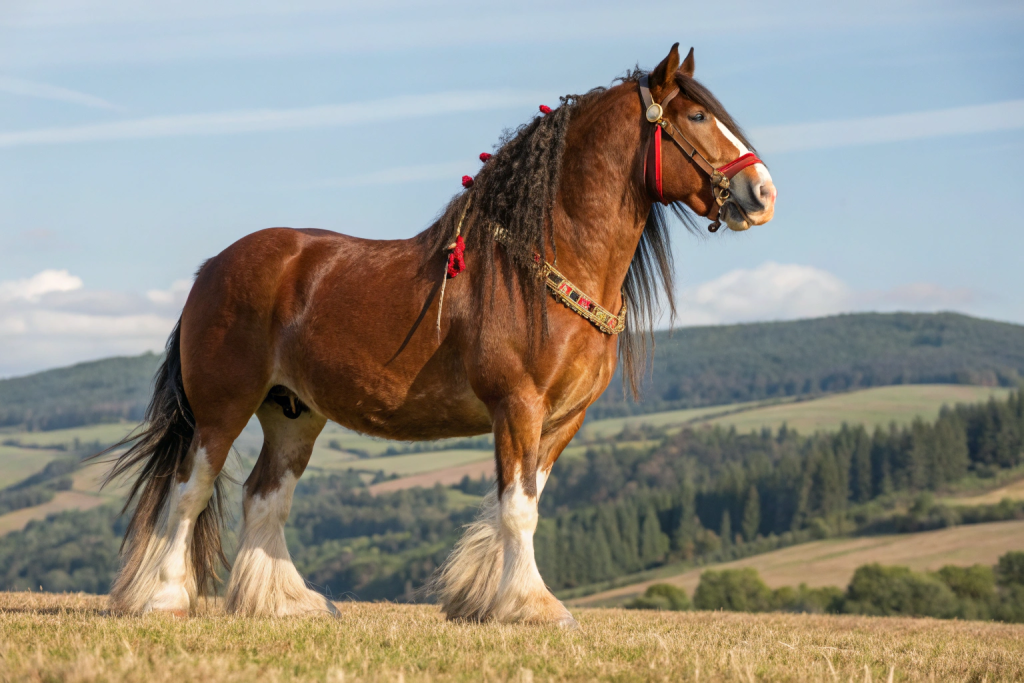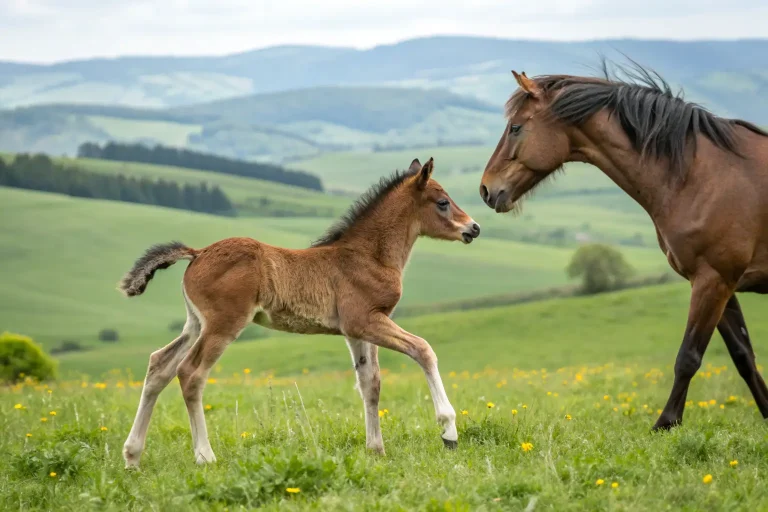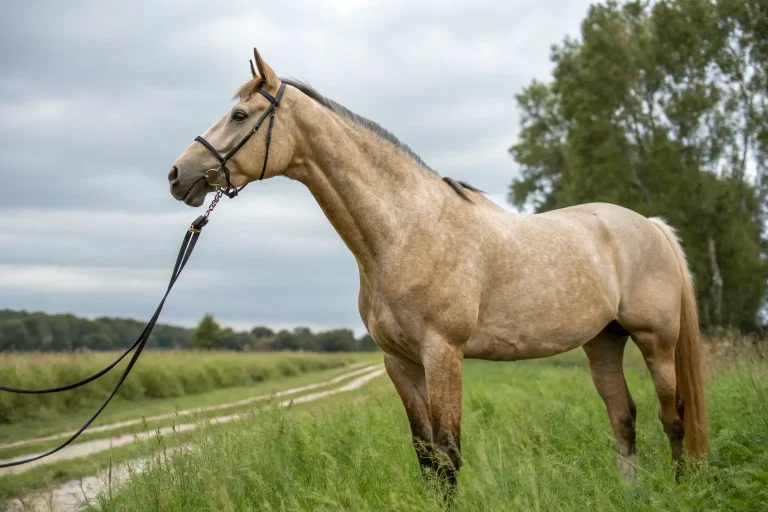Clydesdale Horse: 5 Fascinating Facts You Need To Know
When you hear “Clydesdale horse,” your mind likely conjures images of those majestic gentle giants pulling the famous Budweiser hitch or towering over spectators at parades. Their impressive stature and distinctive feathered legs have made them icons in the equine world. While originating from Scotland’s Clyde Valley, these powerful draft horses have come to represent so much more than their geographic roots.
While breed standards and encyclopedias tell part of the story about these remarkable animals, we’re diving into 5 truly fascinating facts that reveal the unique history, characteristics, and surprising details about the magnificent Clydesdale horse. Beyond their obvious visual appeal lies a story of preservation, purpose, and profound impact on horse culture worldwide.
Fact #1: More Than Just Chrome: The Strict Rules of White Markings
The striking appearance of Clydesdale horses isn’t just beautiful—it’s precisely governed by breed standards that have evolved over centuries. Unlike many other draft breeds that traditionally favor solid colors with minimal markings, Clydesdales are celebrated for their distinctive white patterns.
The ideal Clydesdale displays four white legs extending to the knees and hocks (sometimes called “stockings”), along with a well-defined facial blaze. This pattern isn’t merely aesthetic—it served practical purposes throughout history. In the foggy, often dim Scottish farmlands where Clydesdales originated, these bright white legs offered greater visibility to farmers working with their horses in poor lighting or inclement weather.
The genetics behind these markings is fascinating, with the Sabino gene playing a significant role in producing the classic Clydesdale look. While some variation is acceptable within show standards, the preference for extensive white markings has become increasingly pronounced over generations of selective breeding.
The Clydesdale Horse Society, the premiere authority on breed standards, maintains specific guidelines about acceptable markings, as they’ve become a hallmark of the breed’s identity. This emphasis on distinctive white patterns sets Clydesdales apart from other draft breeds like Percherons or Shires, which typically feature less dramatic markings.
Fact #2: Saved from the Brink: Their Surprising Conservation Story
Few people realize that these magnificent horses nearly disappeared altogether. Following World War II, the rapid mechanization of agriculture dramatically reduced the need for draft horses across the farming world. For Clydesdales, this shift was devastating.
From a peak population estimated at over 200,000 worldwide in the early 20th century, Clydesdale numbers plummeted to critically low levels by the 1970s. In the United Kingdom, fewer than 80 breeding mares remained at one point, placing these horses on the brink of extinction. The Livestock Conservancy listed them as “Threatened,” signaling sehttps://www.animalfriendfacts.com/wp-content/uploads/2024/06/woman-traveling-in-france-2023-11-27-05-16-47-utc_Easy-Resize.com_.jpgus concern for the breed’s survival.
What followed was one of the most remarkable conservation stories in domestic animal history. Dedicated breeders, historical societies, and corporate sponsors like Anheuser-Busch committed to preserving these magnificent animals. Conservation programs established breeding colonies, genetic diversity initiatives were implemented, and public awareness campaigns helped reignite interest in the breed.
Today, while still considered “At Risk” or “Vulnerable” by some conservation organizations, Clydesdale numbers have stabilized. The recovery represents a delicate balance between maintaining traditional breed characteristics while ensuring genetic diversity—a conservation success story that continues to evolve.
Fact #3: Not Just Size, But Substance: They Weigh How Much?!

The sheer scale of a mature Clydesdale horse is genuinely staggering. These equine giants typically weigh between 1,800 and 2,200 pounds—roughly the same as a compact car! Standing between 16 and 18 hands high (64-72 inches at the shoulder), they tower over most other horse breeds.
To put this incredible mass into perspective:
| Comparison | Average Weight |
|---|---|
| Clydesdale Horse | 2,000 lbs |
| Standard Riding Horse | 1,000 lbs |
| Smart Car | 1,800 lbs |
| Adult Male Moose | 1,200 lbs |
Even as newborns, Clydesdale foals typically weigh 150-180 pounds—heavier than many adult humans! This substantial size isn’t merely for show. Their massive frame and powerful muscles developed through centuries of selective breeding for a specific purpose: generating tremendous pulling power for agricultural and industrial work.
A team of Clydesdales could move loads exceeding 8,000 pounds with relative ease. During industrial revolution-era Britain, this strength proved invaluable for hauling heavy cargo like coal, timber, and brewing supplies through cities and across difficult terrain. Their power-to-weight ratio, combined with a willingness to work, made them indispensable before engine-powered transportation.
Despite their imposing size, Clydesdales maintain a relatively elegant confirmation compared to some other draft breeds, with cleaner lines and more animated movement that belies their massive weight.
Fact #4: The Famous Feathering Has a Practical Purpose
Those beautiful flowing “feathers”—the abundant long hair that adorns a Clydesdale’s lower legs—aren’t just for show. This distinctive feature evolved with a practical purpose tied directly to the breed’s Scottish homeland.
The Clyde Valley region of Scotland, where these horses originated, is known for its cool, damp climate and often wet, boggy working conditions. The thick feathering served as natural protection against these harsh elements, helping to:
- Channel water and mud away from the lower leg and sensitive tissues
- Provide insulation against cold temperatures
- Offer some protection against abrasions from rough terrain and vegetation
The feathering is a characteristic shared with several other draft breeds that developed in similar northern European climates, but Clydesdales typically display some of the most abundant and silky leg hair.
Modern Clydesdale owners know these beautiful feathers come with maintenance challenges. The thick hair requires regular cleaning and conditioning to prevent skin conditions like “scratches” (pastern dermatitis), especially in humid environments. Show horses receive meticulous feather care, often involving specialized shampoos, conditioners, and careful wrapping to maintain their pristine appearance.
This practical adaptation has become one of the breed’s most cherished visual characteristics—a reminder of the harmonious balance between function and beauty in these magnificent animals.
Fact #5: The Budweiser Connection: More Than Just a Mascot
While many know Clydesdales through their famous association with Budweiser, few realize the extraordinary standards and history behind this iconic partnership.
The connection began in 1933 when August A. Busch, Jr. surprised his father with a six-horse Clydesdale hitch to celebrate the repeal of Prohibition. What started as a memorable gesture evolved into one of the most successful and enduring brand ambassadorships in marketing history.
Today’s Budweiser Clydesdales must meet exacting requirements:
- Bay coloration (never gray, black, or chestnut)
- Four white stockings extending to the knees and hocks
- Distinct facial blaze
- Black mane and tail
- Standing at least 18 hands high (72 inches at shoulder)
- Weighing between 1,800-2,300 pounds
- Geldings only, typically between 4-10 years old
- Exceptional temperament and trainability
Only about 30-40 horses meet these standards and actively travel as part of the Budweiser hitch teams. They receive world-class care, with dedicated teams of handlers providing specialized nutrition, exercise programs, and veterinary attention.
Beyond their marketing role, the Budweiser program has contributed significantly to Clydesdale conservation efforts. Their breeding farm maintains one of the largest high-quality Clydesdale herds globally, helping preserve genetic diversity within the breed while showcasing these horses to millions of admirers worldwide.
Where Do Clydesdales Excel Today?
While their days as primary agricultural workers have largely passed, modern Clydesdales continue to showcase their versatility in numerous roles:
- Exhibition and Parades: Their stunning appearance and calm demeanor make them perfect for public events
- Pleasure Driving: Recreational carriage driving enthusiasts prize their smooth movement and willing attitude
- Sustainable Logging: Small-scale, environmentally sensitive forestry operations utilize their power in areas where machinery would damage delicate ecosystems
- Riding: Though not their primary purpose, well-trained Clydesdales can make surprisingly comfortable riding horses for larger individuals
- Therapy Programs: Their gentle nature makes them excellent partners in equine-assisted therapy settings
- Crossbreeding: Introducing Clydesdale bloodlines to create warmbloods with both size and athletic ability for sports like dressage
Frequently Asked Questions About Clydesdales
How big do Clydesdales get?
Clydesdales typically stand between 16-18 hands high (64-72 inches at the shoulder) and weigh between 1,800-2,200 pounds. Males (geldings and stallions) are generally larger than mares. The Budweiser Clydesdales, selected for their impressive stature, often reach the upper end of this range.
What are Clydesdales used for?
Historically, Clydesdales were agricultural workhorses used for plowing, hauling heavy loads, and powering machinery. Today, they excel in exhibition driving, parades, pleasure driving, logging, and therapeutic riding programs. They’re also valued for crossbreeding to add size and strength to sport horse bloodlines.
Are Clydesdales good riding horses?
While not traditionally bred for riding, well-trained Clydesdales can make suitable mounts, especially for larger riders. Their calm temperament is an advantage, though their wide barrel requires a specialized saddle. Their movement tends to be surprisingly smooth despite their size, but they’re generally better suited to walking and trotting rather than extended cantering or jumping.
How long do Clydesdales live?
The average Clydesdale lifespan ranges from 25-30 years with proper care. As with most horses, factors like nutrition, exercise, dental care, and preventative veterinary attention significantly impact longevity. Despite their size, they don’t typically have shorter lifespans than lighter horse breeds when well-maintained.
Are Clydesdales rare?
Yes, Clydesdales remain relatively rare, with global population estimates around 5,000-7,000 registered animals. They’re classified as “Vulnerable” or “At Risk” by several livestock conservation organizations. While no longer in immediate danger of extinction as they were in the 1970s, preserving genetic diversity within the breed remains an important conservation concern.
The Enduring Legacy of the Gentle Giants
The Clydesdale horse represents far more than just its impressive physical attributes. Their story encompasses agricultural heritage, conservation challenges, and the unique bond between humans and working animals. From nearly disappearing in the mid-20th century to becoming beloved cultural icons, Clydesdales embody resilience and adaptation.
What makes these horses truly special isn’t just their striking appearance or incredible strength—it’s their remarkable combination of power and gentleness, size and grace. For centuries, these gentle giants have worked alongside humans, demonstrating intelligence, willingness, and a steady temperament that continues to endear them to horse enthusiasts worldwide.
Which of these Clydesdale facts surprised you most? Have you ever had a personal experience with these magnificent horses? Share your thoughts in the comments below!







